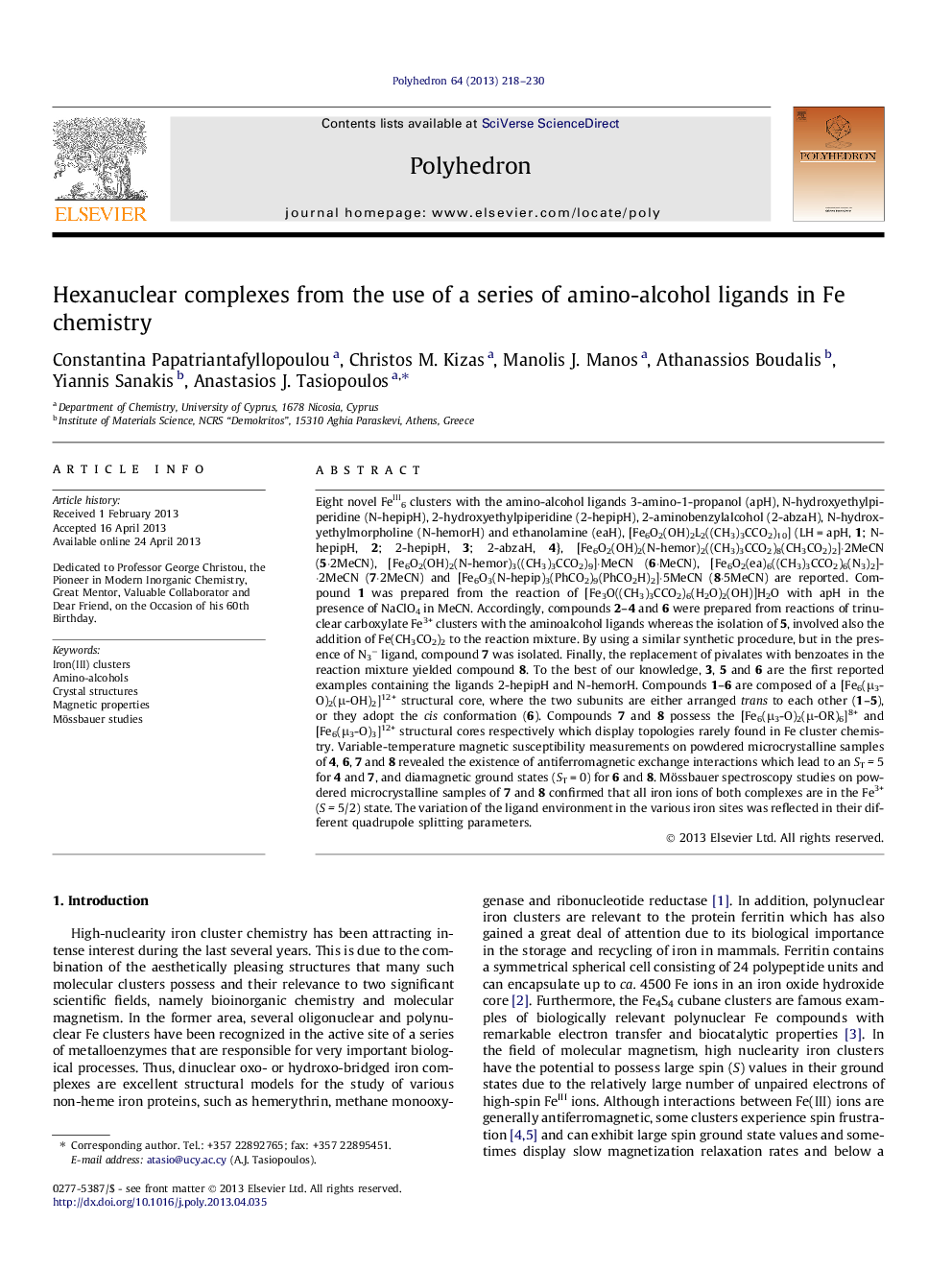| کد مقاله | کد نشریه | سال انتشار | مقاله انگلیسی | نسخه تمام متن |
|---|---|---|---|---|
| 1337044 | 1500275 | 2013 | 13 صفحه PDF | دانلود رایگان |

Eight novel FeIII6 clusters with the amino-alcohol ligands 3-amino-1-propanol (apH), N-hydroxyethylpiperidine (N-hepipH), 2-hydroxyethylpiperidine (2-hepipH), 2-aminobenzylalcohol (2-abzaH), N-hydroxyethylmorpholine (N-hemorH) and ethanolamine (eaH), [Fe6O2(OH)2L2((CH3)3CCO2)10] (LH = apH, 1; N-hepipH, 2; 2-hepipH, 3; 2-abzaH, 4}, [Fe6O2(OH)2(N-hemor)2((CH3)3CCO2)8(CH3CO2)2]·2MeCN (5·2MeCN), [Fe6O2(OH)2(N-hemor)3((CH3)3CCO2)9]·MeCN (6·MeCN), [Fe6O2(ea)6((CH3)3CCO2)6(N3)2]·2MeCN (7·2MeCN) and [Fe6O3(N-hepip)3(PhCO2)9(PhCO2H)2]·5MeCN (8·5MeCN) are reported. Compound 1 was prepared from the reaction of [Fe3O((CH3)3CCO2)6(H2O)2(OH)]H2O with apH in the presence of NaClO4 in MeCN. Accordingly, compounds 2–4 and 6 were prepared from reactions of trinuclear carboxylate Fe3+ clusters with the aminoalcohol ligands whereas the isolation of 5, involved also the addition of Fe(CH3CO2)2 to the reaction mixture. By using a similar synthetic procedure, but in the presence of N3− ligand, compound 7 was isolated. Finally, the replacement of pivalates with benzoates in the reaction mixture yielded compound 8. To the best of our knowledge, 3, 5 and 6 are the first reported examples containing the ligands 2-hepipH and N-hemorH. Compounds 1–6 are composed of a [Fe6(μ3-O)2(μ-OH)2]12+ structural core, where the two subunits are either arranged trans to each other (1–5), or they adopt the cis conformation (6). Compounds 7 and 8 possess the [Fe6(μ3-O)2(μ-OR)6]8+ and [Fe6(μ3-O)3]12+ structural cores respectively which display topologies rarely found in Fe cluster chemistry. Variable-temperature magnetic susceptibility measurements on powdered microcrystalline samples of 4, 6, 7 and 8 revealed the existence of antiferromagnetic exchange interactions which lead to an ST = 5 for 4 and 7, and diamagnetic ground states (ST = 0) for 6 and 8. Mössbauer spectroscopy studies on powdered microcrystalline samples of 7 and 8 confirmed that all iron ions of both complexes are in the Fe3+ (S = 5/2) state. The variation of the ligand environment in the various iron sites was reflected in their different quadrupole splitting parameters.
The use of a series of amino-alcohol ligands in Fe cluster chemistry has afforded eight novel FeIII6 compounds, some of which possess metal topologies, which have been rarely appeared in Fe cluster chemistry. The coordination chemistry of the amino – alcohol ligands employed in the present study is not well explored or even completely unexplored; three of the reported compounds are the initial examples of metal clusters containing the ligands 2-hepipH and N-hemorH.Figure optionsDownload as PowerPoint slide
Journal: Polyhedron - Volume 64, 12 November 2013, Pages 218–230